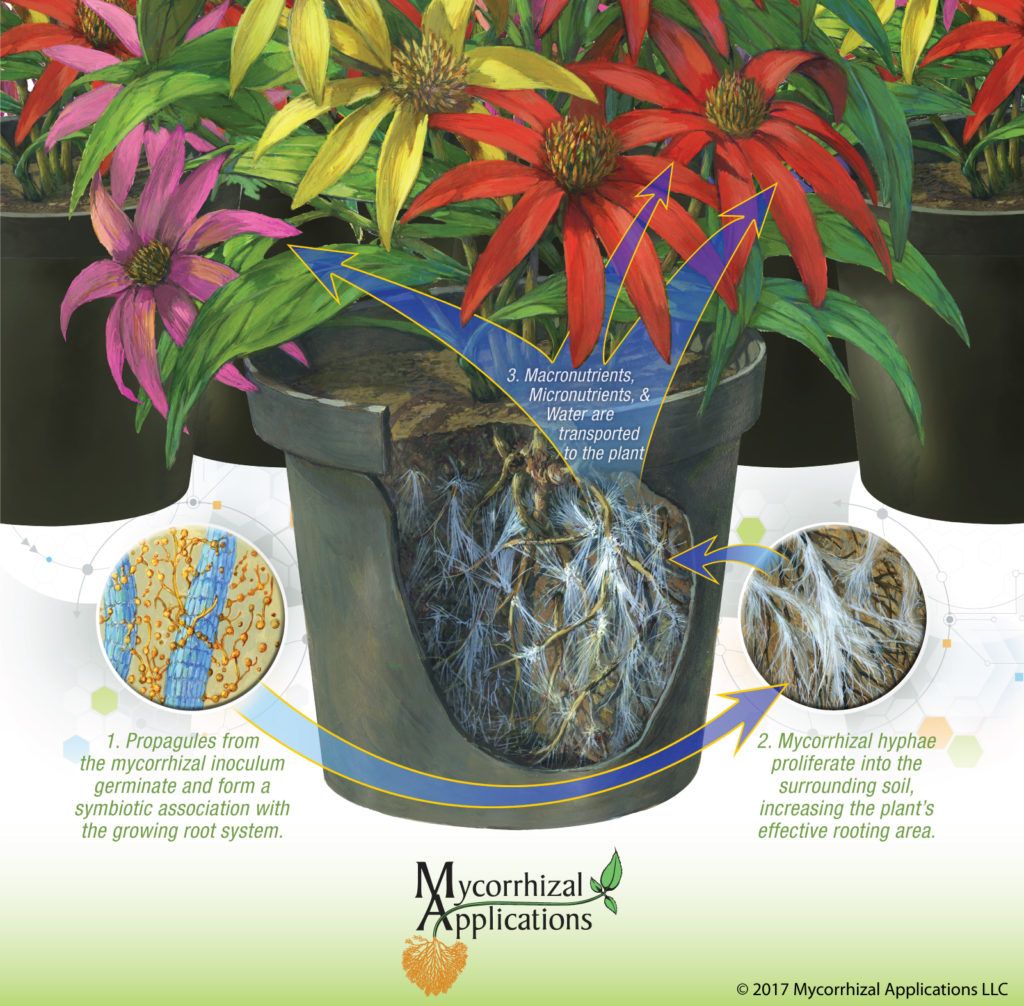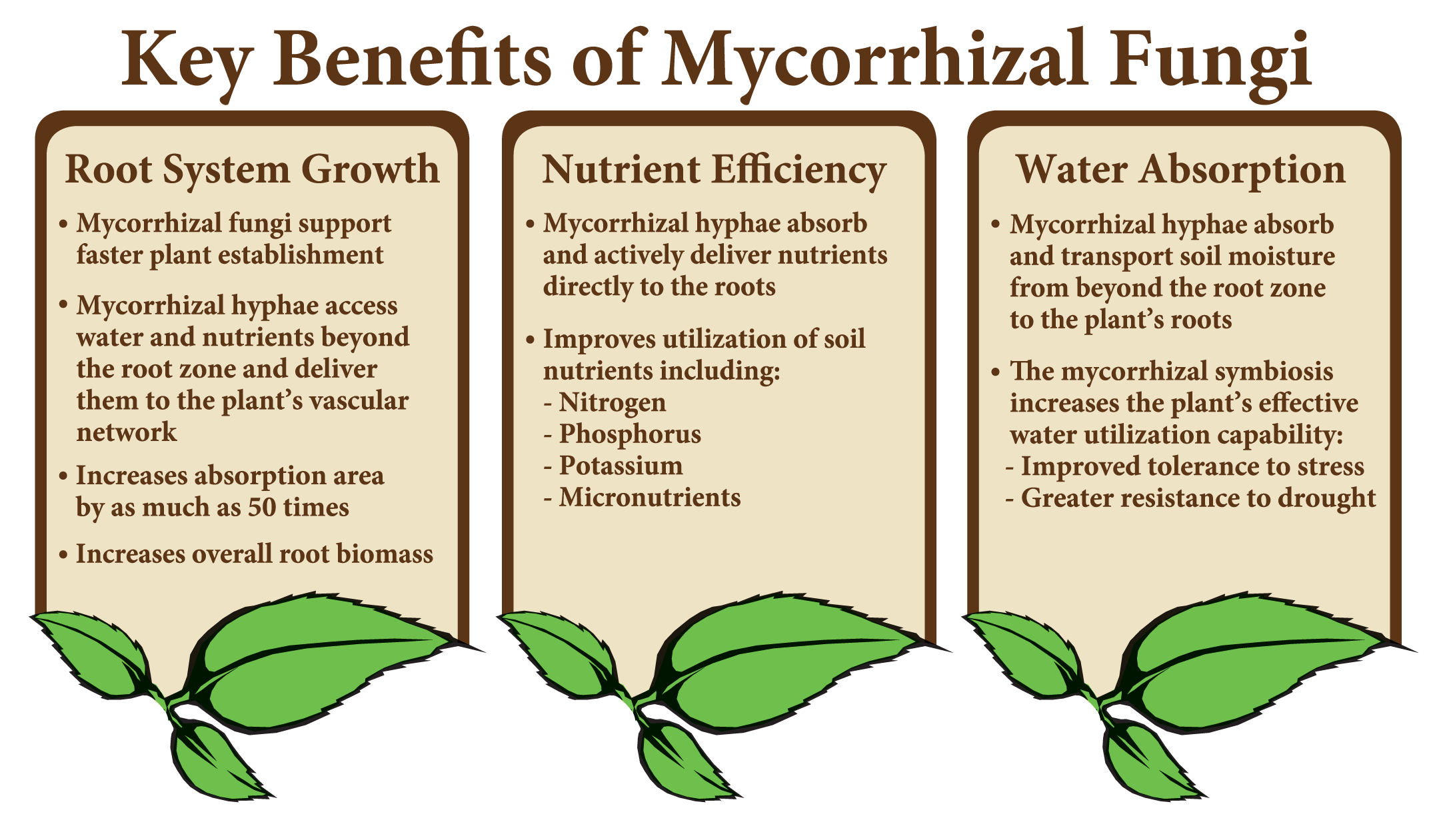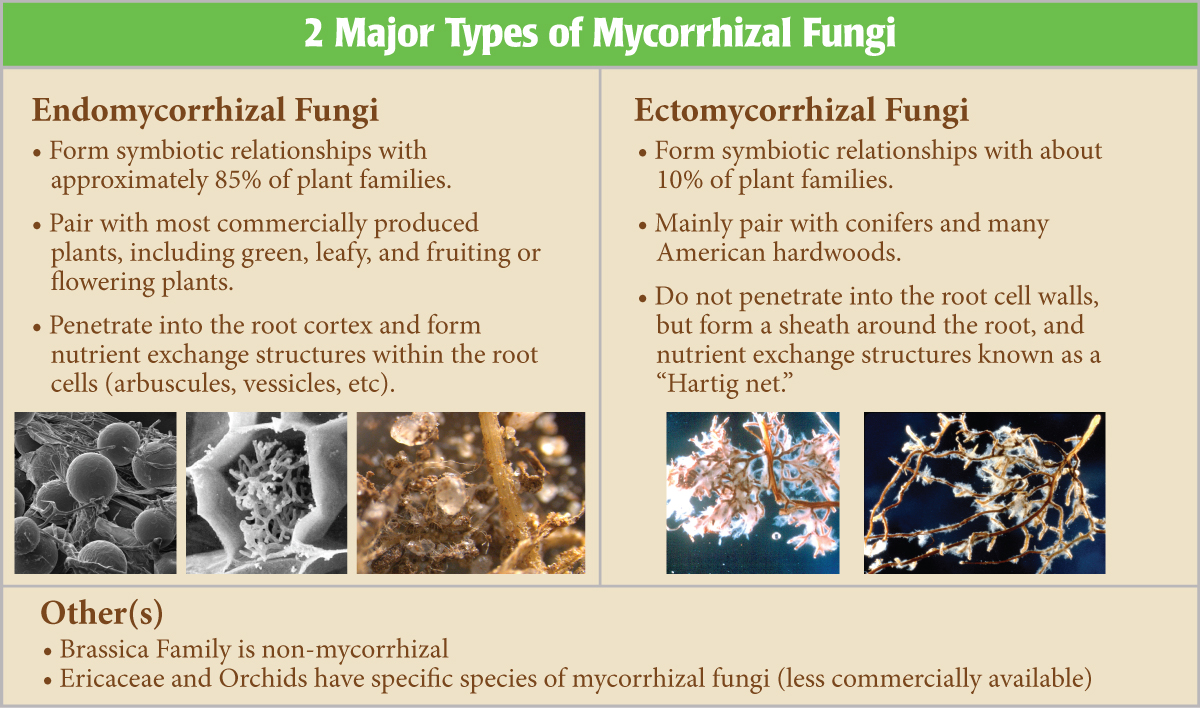What Are Mycorrhizae?
“Myco” – “rhiza” literally means “fungus” – “root” and describes the mutually beneficial relationship between the plant and root fungus. These specialized fungi colonize plant roots in a symbiotic manner and extend far into the soil. Mycorrhizal fungal filaments in the soil are truly extensions of root systems and are more effective in nutrient and water absorption than the roots themselves. More than 95 percent of terrestrial plant species form a symbiotic relationship with beneficial mycorrhizal fungi, and have evolved this symbiotic relationship over the past several hundred million years. These fungi predate the evolution of terrestrial plants, and it was the partnership with mycorrhizal fungi that allowed plants to begin to colonize dry land and create life on Earth as we know it.
The mycorrhizal symbiotic relationship centers on the plant’s ability to produce carbohydrates through photosynthesis and share some of these sugars with the fungus in return for otherwise unavailable water and nutrients that are sourced from the soil or growing media by the extensive network of mycelial hyphae produced by the fungus. It’s a two-way relationship of sharing resources between two species, thus a classic symbiotic mutualism. The endomycorrhizal fungi rely on the plant, and the plant’s performance and survival are enhanced by the fungus.
How is this Symbiosis Established?
Mycorrhizal fungi can colonize plants from three main sources of inoculum: spores, colonized root fragments, and vegetative hyphae. Collectively, these inoculants are called “propagules,” and this is the standard unit of measure that is listed on most commercially available mycorrhizal products.
To colonize plant roots, these propagules must be present in the substrate and in close proximity to actively growing roots of a compatible plant. The growing root tips emit root exudates as they push through the substrate which signal the fungi to colonize the roots and establish the symbiosis. Once the roots are colonized, then the process is self-sustaining as the mycelia continue to grow with the plant’s root system and additional spores and hyphae are produced.
AMF propagules can be incorporated into the substrate prior to or during planting or they can be top-dressed on the surface and watered into a porous substrate. They can also be applied as a dip or slurry at the time of sticking a cutting, seeding, or at the time of transplanting. The propagules can also be applied as a drench to the soil and watered-in, applied to the outer surface of the rootball before transplanting, or used in transplant hole and backfill soil.
 What are the Main Benefits of Mycorrhizae?
What are the Main Benefits of Mycorrhizae?
There are numerous documented benefits that mycorrhizal fungi provide to plants. The key benefits that mycorrhizae provide to professional growers are: Root System Enhancement, Improved Nutrient Efficiency, and Increased Water Absorption & Utilization.

What are Some of the Other Benefits of Mycorrhizae?
The symbiotic relationship with mycorrhizal fungi provides many additional benefits to plants and their environments, along with the top-three listed above. These additional benefits include Improved Soil Structure, Greater Transplant Success, Increased Stress Tolerance, Reduced Nutrient Runoff, and many more. Please contact our staff if you have any questions about how mycorrhizal inoculation can benefit your operation, plants/projects, and bottom line.
Who Can Benefit from Mycorrhizal Fungi?
This biological or “biorational” technology, as we like to call it, is beneficial to every industry involving soils, plants, and people. These symbiotic organisms have been relied upon for successful reforestation and restoration projects for decades. In agriculture, mycorrhizal fungi are partnering with plants in symbiosis to contribute to sustainably feeding our growing global population, even in drought affected areas, salty soils, desertified farmland, etc. Professional horticulturists, including greenhouse and nursery growers, can also experience the benefits of mycorrhizae in their own growing protocols to grow heartier, more vibrant, and more resilient plants for retail sale and landscape installations. Landscape architects, installers, and maintenance workers have been utilizing mycorrhizal inoculants in transplanting and sustainable landscape design for at least the last couple of decades. Even homeowners who are planting gardens and/or caring for their lawns and landscapes can now utilize this technology, as more and more mycorrhizal retail products are showing up on shelves in garden centers.
What are the Different Types of Mycorrhizal Fungi?

Examples of Endomycorrhizal Fungi:
- Glomus intraradices
- Rhizophagus intraradices
- Rhizophagus irregularis
- Glomus mosseae
- Funneliformis mosseae
- Glomus aggregatum
- Claroideoglomus claroideum
- Glomus etunicatum
- Claroideoglomus etunicatum
- Glomus deserticola
- Glomus clarum
- Glomus monosporum
- Paraglomus brasilianum
- Gigaspora margarita
Examples of Ectomycorrhizal Fungi:
- Rhizopogon villosulus
- Rhizopogon luteolus
- Rhizopogon amylopogon
- Rhizopogon fulvigleba
- Pisolithus tinctorius
- Suillus granulatus
- Laccaria bicolor
- Laccaria laccata
- Scleroderma cepa
- Scleroderma citrinum
How Many Species of Mycorrhizae do I Need?
One of the many benefits of adding mycorrhizae into your growing practices is the fact that these beneficial symbiotic organisms are involved in building a healthy ecosystem for your plants within the growing media rhizosphere. And like any healthy ecosystem, biodiversity is very important. Therefore, selecting products with greater numbers of species of the types of mycorrhizal fungi that you need (either endomycorrhizae, ectomycorrhizae, or both), will offer greater benefits to your plants, throughout their entire life cycles.
Research has shown that diversity of mycorrhizae in the plant’s root system is important, as these different species of mycorrhizae provide different benefits to the plant under variable circumstances. For instance, some species are better at assisting in nutrient uptake, while others are more proficient in assisting the plant with water efficiency, and others are responsible for mitigating toxins and salts from reaching the plant’s vascular system. Research has also shown that different species of mycorrhizae provide different benefits during different seasons, with some doing the heavy lifting early in the growing season, and others kicking in during the warmer drier months, and others providing benefits towards the end of the growing season or throughout the winter.
Therefore, we recommend choosing products with greater diversity (at least 4 species in endomycorrhizal products, and at least 7 species in ectomycorrhizal products), in order to ensure that you are providing the ideal soil microbiome for your growing operation, landscape installation or maintenance, restoration project, arbor care, etc.
Still Have Questions?
For a list of Frequently Asked Questions about mycorrhizae in general, and about specific application tips and pointer, please refer to our FAQ Section: CLICK HERE
If your questions aren’t answered above or within our FAQ section, please feel free to reach out to our experienced and knowledgeable Sales Team:
Email: inquiries@mycorrhizae.com
Phone: (541) 476-3985
Toll Free: (866) 476-7800

